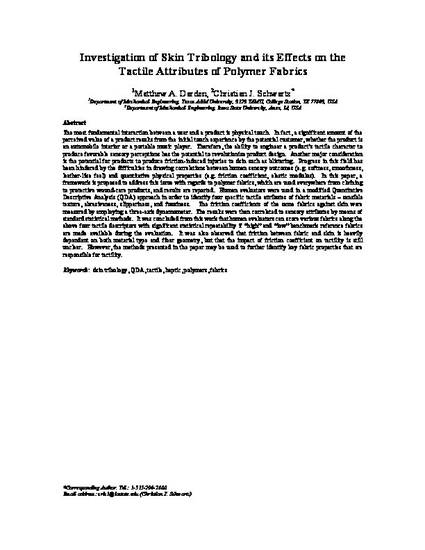
Article
Investigation of Skin Tribology and its Effects on the Tactile Attributes of Polymer Fabrics
Wear
(2009)
Abstract
The most fundamental interaction between a user and a product is physical touch. In fact, a significant amount of the perceived value of a product results from the initial touch experience by the potential customer, whether the product is an automobile interior or a portable music player. Therefore, the ability to engineer a product’s tactile character to produce favorable sensory perceptions has the potential to revolutionize product design. Another major consideration is the potential for products to produce friction-induced injuries to skin such as blistering. Progress in this field has been hindered by the difficulties in drawing correlations between human sensory outcomes (e.g. softness, smoothness, leather-like feel) and quantitative physical properties (e.g. friction coefficient, elastic modulus). In this paper, a framework is proposed to address this issue with regards to polymer fabrics, which are used everywhere from clothing to protective wound-care products, and results are reported. Human evaluators were used in a modified Quantitative Descriptive Analysis (QDA) approach in order to identify four specific tactile attributes of fabric materials – sensible texture, abrasiveness, slipperiness, and fuzziness. The friction coefficients of the same fabrics against skin were measured by employing a three-axis dynamometer. The results were then correlated to sensory attributes by means of standard statistical methods. It was concluded from this work that human evaluators can score various fabrics along the above four tactile descriptors with significant statistical repeatability if “high” and “low” benchmark reference fabrics are made available during the evaluation. It was also observed that friction between fabric and skin is heavily dependent on both material type and fiber geometry, but that the impact of friction coefficient on tactility is still unclear. However, the methods presented in the paper may be used to further identify key fabric properties that are responsible for tactility.
Keywords
- skin tribology,
- QDA,
- tactile,
- haptic,
- polymers,
- fabrics
Disciplines
Publication Date
2009
DOI
10.1016/j.wear.2008.12.041
Publisher Statement
Copyright 2009 Elsevier B.V.
Citation Information
Matthew A Darden and Christian J. Schwartz. "Investigation of Skin Tribology and its Effects on the Tactile Attributes of Polymer Fabrics" Wear Vol. 267 (2009) p. 1289 - 1294 Available at: http://works.bepress.com/christian-schwartz/21/
Creative Commons license

This work is licensed under a Creative Commons CC_BY-NC-ND International License.
